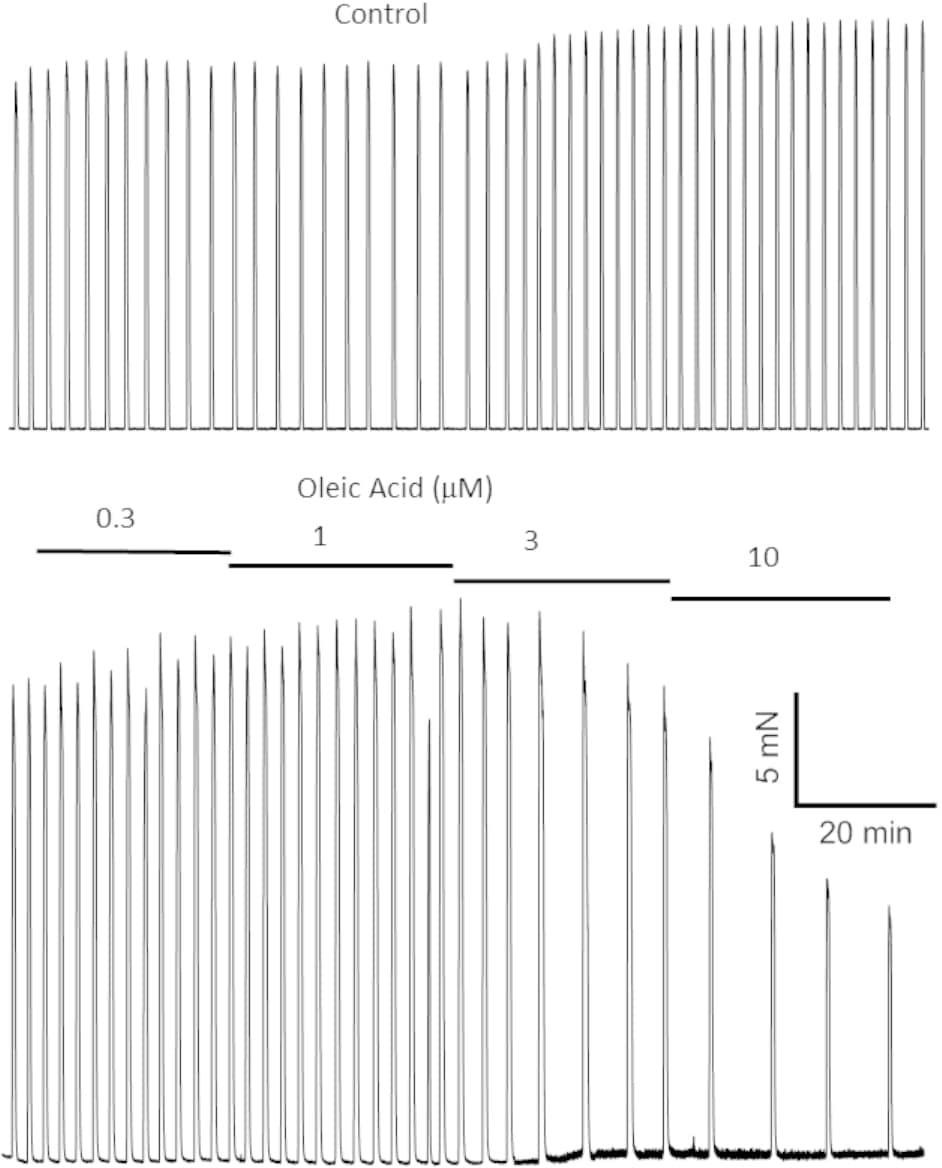Obesity is a major health problem throughout the developed world, especially among women of childbearing age. In pregnancy, obesity is associated with an increased risk of prolonged and dysfunctional labour and increased risk of caesarean section, post-date pregnancy and post-partum haemorrhage Our recent work using a rat model of maternal obesity has revealed decreased expression of Cx43, a major gap junction protein responsible for the synchronisation of uterine contractions, that was accompanied by desynchronised and weak contractions of the myometrial strips ex vivo [1]. Feeding the rats a high fat high cholesterol diet also leads to a significant rise in plasma concentrations of oleic acid, a monounsaturated fatty acid implicated in modulation of many regulatory processes in excitable cells [2]. The aim of the present study was to investigate the in-vitro effects of oleic acid on myometrial contractility in lean pregnant rats. The experiments were approved by the UAEU Animal Ethics Committee (ERA_2016_4261). The rats were humanly killed by cervical dislocation after CO2 anaesthesia. Strips of longitudinal myometrium were dissected under the dissection microscope and mounted in an automated organ bath (TOBS 750, DMT, Denmark). After one hour equilibration, 0.25 nM oxytocin was applied and 40 min later water soluble oleic acid (Sigma O1257) was added accumulatively at concentrations ranging from 0.1 to 100 mM every 20 minutes. Time-matched control strips were exposed to vehicle only (Methyl-b-cyclodextrin (MCD), Aldrich 332615). The contractility of the myometrium was characterised by activity integral measured as area under the curve during the last 10 min at each concentration of oleic acid or MCD that was normalised to the activity integral of each strip before the additions of oleic acid or vehicle were commenced. The normalised activity integral values were compared between different concentrations using One-way ANOVA followed by Kruskal-Wallis test. The results of our experiments show that oleic acid caused a dose-dependent inhibition of myometrial contractile activity at concentrations above 3 mM (Fig. 1, bottom trace) while the addition of MCD at concentration equivalent to that in 100 mM oleic acid caused small increase in activity integral (Fig. 1 top trace). At lower concentrations, there were no statistically significant changes in contractile activity. As illustrated in Fig. 1, the decrease in activity integral in response to oleic acid was due to decrease in both, the amplitude and the frequency of myometrial contractions. In conclusion, our data show a direct inhibitory effect of oleic acid on myometrial contractility, which at least in part, may explain poor myometrial contractility in obese rats observed in our previous studies.
Physiology 2019 (Aberdeen, UK) (2019) Proc Physiol Soc 43, PC266
Poster Communications: Oleic acid inhibits oxytocin stimulated myometrial contractions in strips from pregnant rat myometrium.
N. M. Hag1, M. J. Elmes2, A. Shmygol1
1. Department of Physiology, United Arab Emirates University, Al Ain, United Arab Emirates. 2. Division of Food, Nutrition and Dietetics, University of Nottingham, Loughborough, United Kingdom.
View other abstracts by:
Representative tracings of myometrial contractions recorded from longitudinal strips exposed to vehicle (upper trace) of progressively increasing concentrations of oleic acid (marked by solid bars with concentrations above them).
Where applicable, experiments conform with Society ethical requirements.

